General information about perimeter area
Basic definition of perimeter area
The perimeter generally comprises certain areas of the court that are outside of the lane away from the basket.
Main perimeter areas on the basketball court
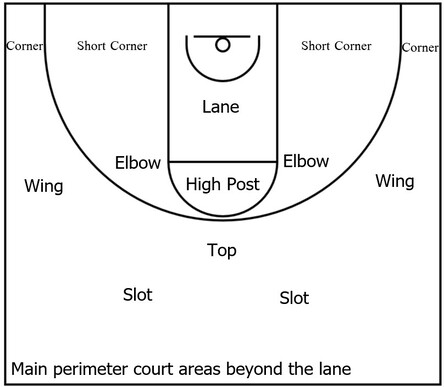
The main areas of the court that are generally considered as the perimeter include the top, wings, corners, slots, the high post alongside the elbows, as well as the short corners.
Furthermore, the top, wings, corners, and slots are primarily beyond the three-point line while the high post and short corners are within the three-point line.
Once again, each of these areas are outside of the lane, which is the boxed area below the high post/free throw line that also contains the basket.
The adjacent diagram above showcases the general perimeter areas that players on the court could occupy, which are also outside of the lane.
In addition, the information below contains a brief description for each area.
Moreover, as a side note, there are at least two specific areas that are outside of the lane but at the same time, those areas are generally not considered perimeter spots on the court.
These particular areas are known as the left side and right side low post areas.
In essence, the low post areas are generally not considered perimeter spaces because they are simply very close to the basket while all other locations outside of the lane are further away from the basket.
Top
The top, sometimes referred to as top of the key or the point, is the general area located above the high post, commonly behind the three-point line, in the middle of the offensive team’s frontcourt.
Wings
The wings consists of the court areas behind the three-point line that are adjacent to the nearest sideline, which is generally at or above the free throw line extended, an imaginary line expanded from the edges of the free throw line.
Corners
The corners comprise the areas behind the three-point line that are in the general vicinity of a sideline and its adjoining baseline.
Slots
The slots, sometimes referred to as the lane line extended areas, are specific spots above the three-point line between the top and the wings.
High post + Elbows
The high post is the general area that covers the free throw line from one edge to the other as well as the adjacent area that is between the free throw line and the top of the three-point line.
Additionally, the edges of the free throw line are typically known as the high post elbows or simply, the elbow areas of the court.
Short corners
The short corners are the general areas inside of the three-point line that are between the corner and the basket.
The short corners are also slightly below the low post areas and adjacent to the baseline.
General information about perimeter players
Basic definition of perimeter player
A perimeter player is a type of basketball player that primarily plays on or around the perimeter areas of the court, particularly near the top, the wings, the corners, or the slots in some instances.
Main types of perimeter players
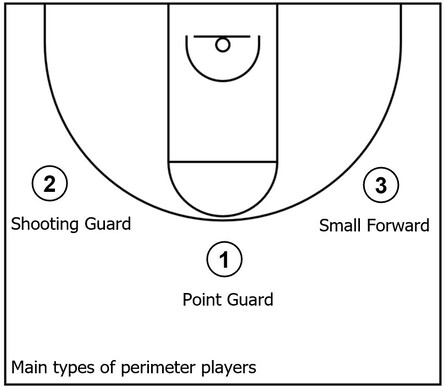
The main types of perimeter players consist of the standard basketball positions known as the point guard, shooting guard, and small forward.
The adjacent diagram above displays the point guard filling space in the top perimeter area while the shooting guard and small forward occupy the left and right wing perimeter areas respectively.
Additionally, the point guard can be denoted simply as the number 1, which is shown on the diagram above, or as the 1-guard.
The shooting guard can be indicated as the number 2, which is displayed on the diagram above, or as the 2-guard.
Finally, the small forward is generally indicated by the number 3, which is also represented on the diagram above.
Point guard
The point guard has the primary role of initiating the offense as well as dribbling and passing the ball to ultimately create scoring opportunities near the basket or around perimeter areas of the court.
The simple diagram below shows the point guard executing pick and roll action near the wing perimeter area alongside a traditional post player, which is another type of basketball position known as the center.
Also, note that this post player is signified by the number 5.
Example: Basic pick and roll on the wing perimeter area
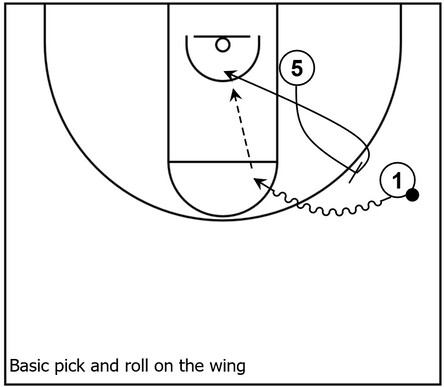
For the basic diagram immediately above, the point guard, denoted as 1, has possession of the basketball, shown via the black dot.
Next, 1 uses the pick, also known as the on-ball screen, that is set by the center, indicated as 5. From there, 1 dribbles toward the high post area, represented by the wavy arrow.
Following the pick, 5 rolls to the basket, shown with the solid arrow, and receives the ball via a pass from 1, indicated by the dotted arrow.
After receiving possession of the ball, 5 could score near the rim via a layup or slam dunk.
Shooting guard
The shooting guard primarily scores points, particularly around perimeter areas of the court, especially after gaining possession of the ball from another player such as the point guard.
The diagram below showcases a typical action of the shooting guard; utilizing an off-ball screen from yet another type of basketball position, commonly known as the power forward, to get open for a potential scoring opportunity.
Example: Basic down screen with cut towards wing perimeter area
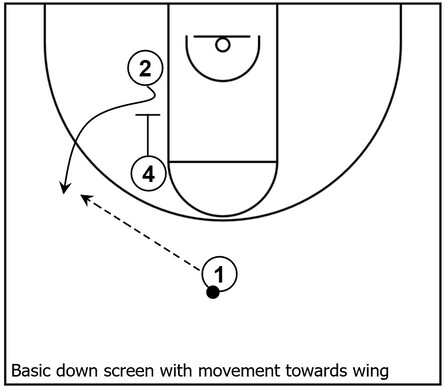
On the adjacent diagram above, the point guard, denoted as 1, has possession of the ball at the top.
The shooting guard, denoted as 2, is initially occupying the left side low post area while the power forward, denoted as 4, initially fills the left side high post elbow.
Next, 2 cuts to the left side wing via a common off-ball screen, known as a down screen, set by 4.
Afterwards, 2 receives the ball from 1 and has an opportunity to score, specifically via a jump shot, assuming that is open.
Additionally, as a side note to the power forward, in the traditional sense, this particular position is commonly a post player.
However, in certain offensive strategies or even depending on coaching philosophy in relation to team personnel, the power forward could be utilized more as a perimeter player, specifically beyond the three-point line.
It is not shown here but as an example, within the Princeton offense, the power forward or simply 4, can operate from the top, wings, or corners, particularly as a three-point shooter or to utilize certain off-ball or on-ball screens.
Small forward
The small forward generally focuses on doing a little bit of everything from scoring points, making plays (e.g. passing the ball, which then leads to an assist), rebounding, or defending.
The diagram below shows a common action that could be utilized by perimeter players such as the small forward; the backdoor cut.
Example: Basic backdoor cut from the wing perimeter area to the basket
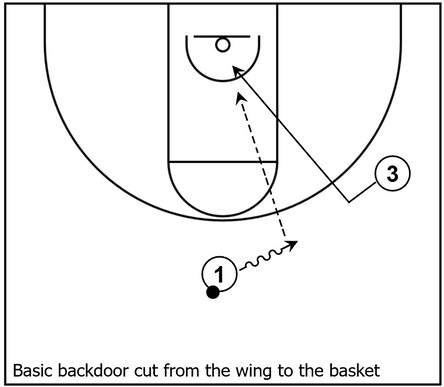
The adjacent diagram displays the point guard, denoted as 1, at the top and the small forward, indicated as 3 on the right side wing.
1 simply takes a dribble towards 3, which leads to an automatic backdoor cut from the wing to the basket by 3.
3 receives the ball from 1 and has an opportunity to score at the rim, particularly with a layup.
General information about perimeter shots
Basic definition of perimeter shot
A perimeter shot in basketball generally comprises any shot by an offensive player, with the exception of a free throw, that is taken outside of the lane and away from the basket.
Types of perimeter shots
Generally speaking, there are two types of perimeter shots; the mid-range shot and the three-point shot.
Mid-range shot
A mid-range shot is a type of perimeter shot that is taken outside of the lane away from the basket but within the three-point line.
Furthermore, as a side note, this particular shot is generally referred to as “mid-range” because it is attempted in an area of the court that is within the middle (or between) the close-range (i.e. lane/paint area) and the three-point range.
The diagram below shows a very simple example of a mid-range shot.
Example: Simple mid-range shot
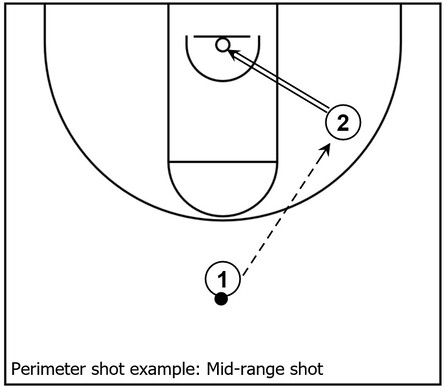
On the adjacent diagram, 1 is at the top with possession of the ball, represented by the black dot, and 2 is just inside of the three-point line near the wing.
2 receives the ball from 1 and takes an easy mid-range shot, represented by the wide arrow pointing towards the basket.
Three-point shot
The three-point shot is a type of perimeter shot that is attempted behind the three-point line, which is an arc that surrounds the basket from one baseline to the other.
Additionally, the three-point shot is sometimes referred to as a three-point field goal, 3-pointer, 3-ball, or simply as 3, not to be confused with the commonly numbered designation for the small forward position.
The diagram below demonstrates a simple example of a three-point shot.
Example: Simple three-point shot
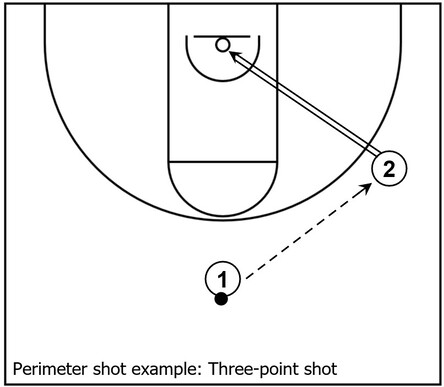
For the immediate diagram above, 1 is at the top with possession of the ball, indicated by the black dot, and 2 is filling the right side wing behind the three-point line.
From there, 2 receives the ball from 1 and quickly takes the three-point shot, shown via the wide arrow pointing towards the basket.
General information about perimeter defense
Basic definition of perimeter defense
Perimeter defense is a basketball defensive concept generally associated with systems, strategies, or tactics that are designed to limit or prevent offensive plans of actions, particularly near perimeter areas of the court, which could lead to reduced offensive scoring production and/or turnovers.
Basic information about perimeter defender
A perimeter defender could be considered any defensive player who is guarding any respective offensive player near a perimeter area of the court.
Generally speaking, the common perimeter players, particularly the point guard, shooting guard, and small forward, will usually be their respective team’s main perimeter defenders.
However, it is possible for other defenders who are not typically perimeter players to act as additional or secondary perimeter defenders in certain instances.
For example, a traditional post player such as a defensive center might become a secondary perimeter defender if their respective assignment, such as an offensive center, fills a perimeter area on the court such as the corner.
Basic elements of perimeter defense
Defensive stance
The defensive stance comprises a type of athletic low posture utilized by one or more defensive players to more efficiently react to various actions by one or more offensive players, which, in turn, could also result in limited scoring opportunities.
The fundamental components that are key for a perimeter defender to execute a proper defensive stance consists of feet that are slightly wider than shoulder width apart, knees that are slightly bent, and a back that is straightened as much as possible.
Each of these foundational elements can help a perimeter defender maintain balance, which is essential to playing adequate defense.
Also, perimeter defenders should try to remain on the balls of the feet and not stand flat-footed. Moreover, perimeter defenders should have their hands up with their arms extended away from their sides.
Additionally, perimeter defenders that are directly guarding the offensive player with the ball should generally have their hands mirror the ball.
That is to say, if the ball is high near the offensive player’s chest or above the shoulders, then the hands of the perimeter defender should typically be high as well.
By having active hands, the perimeter defender may be able to deflect the ball if the offensive player attempts to pass it to another teammate.
Conversely, if the ball is low near the offensive player’s waist or below the waist, then the hands of the defender should be low as well.
What’s more, in that instance, if the offensive player is a good mid-range or three-point shooter, then the perimeter defender guarding that same offensive player could place one hand near the face of that particular offensive player while the other hand is near the ball.
By doing that, the perimeter defender could take away a potential perimeter shot attempt and at the same time, the defender is in a position to completely stop or at least, slow down any feasible dribble penetration by the offensive player.
It should be mentioned as well that a perimeter defender should not touch an offensive player with illegal contact as that could lead to a defensive foul being assessed against that defender.
Defensive sliding
Defensive sliding consists of action that occurs when a defender, initially within a defensive stance, moves their feet in a lateral fashion from side to side.
As a brief example of defensive sliding, let’s say that a perimeter defender desires to move to their right, then that same defender should move laterally (i.e. from side to side) with the right foot leading first followed by the left foot after that.
Conversely, if the perimeter defender desires to move to their left, then that same defender should move laterally (i.e. from side to side) with the left foot leading first followed by the right foot afterwards.
It should also be stated that the perimeter defender’s feet should never be too close together while performing the defensive slide as that would generally diminish their lateral quickness.
Furthermore, it is most likely apparent but a perimeter defender should not cross their feet while executing the defensive slide as well.
Doing so would not only eliminate the perimeter defender’s ability to effectively slide laterally, but it could also cause the defender to lose balance.
The diagram below demonstrates a basic example of the defensive sliding concept.
Example: Basic defensive sliding
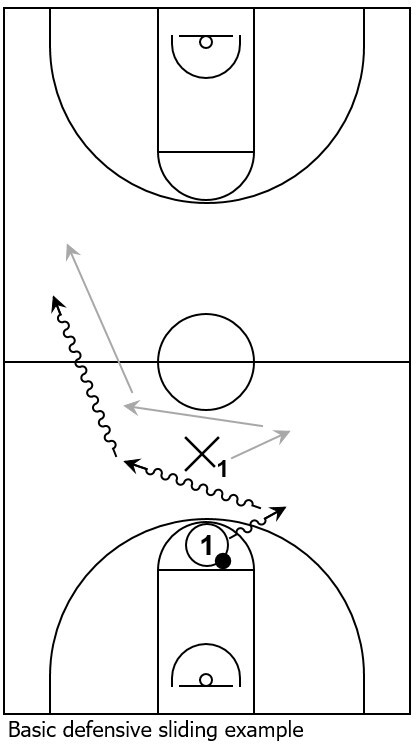
This is a full court example of basic defensive sliding from a typical perimeter defender via 1 on 1 action.
In essence, a defensive point guard, denoted as X1, is guarding against an offensive point guard with possession of the basketball, denoted as 1.
Initially, the offensive point guard begins in their backcourt and attempts to dribble the ball into their frontcourt.
At the same time, the defensive point guard gets into the defensive stance and begins sliding their feet laterally from side to side, represented by the gray arrows.
As the offensive point guard dribbles toward the right side of the court at the start, the defensive point guard slides to their left in an attempt to stay in front of the ball while cutting off the dribbling pathway.
Following that, the offensive point guard switches direction and begins to dribble towards their left. To counter this, the defensive point guard begins to slide to their right.
The offensive point guard keeps dribbling the basketball into their frontcourt while the defensive point guard continues their objective to hinder the opponent’s dribbling while remaining in front of the ball.